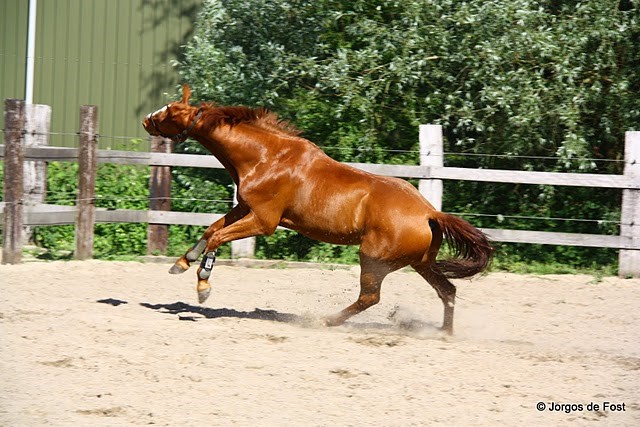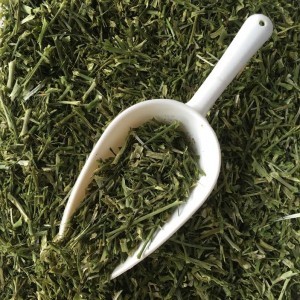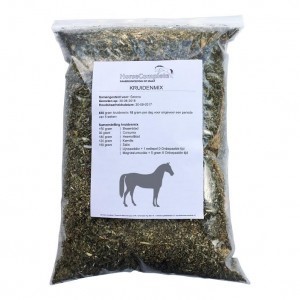FEED MANAGEMENT - THE DANGER OF SHORTAGES AND SURPLUSES
In my work as a nutritional specialist at The Horse Therapist I come across all kinds of things. From a 10-year-old Spanish gelding who was fed 5 kilos of concentrate per day, including 2 kilos of sweet muesli with apple flavour, to an 8-year-old KWPN mare who only got limited roughage. Your reading that correct: limited!
But why, that's not good, is it?
The owner of the gelding thought he needed all this energy, because “he did so much” and he just didn't want to get fuller and more muscular. So over time she had fed him more and more and more concentrates. She was afraid that he was lacking in nutrients and she felt good about pampering him like that. He was not really skimpy, but all muscles felt hard and tense and he had a tucked-up stomach. Mentally he was not himself at all and he misbehaved terribly by being frightened and biting out of frustration. He also always had to be lunged first to get all his pent up energy out before he could be ridden. After that he was quickly “tired” and he no longer wanted to walk smoothly, hence all that food.
The story of the mare ...
It was a completely different story with the mare. She was skimpy and not muscled, so she had a bare top line and was very slow to ride and often stiff. She was often in heat and had a dull long coat and poor hooves. You were not allowed to tease her, because she would get angry, she was very shivery to the skin and girthing was a drama. Not a happy horse, but very good to ride and bombproof. This owner said: We don't do much with her, just some recreational riding, so why feed her more? Roughage alone is enough, horses only eat grass anyway. And if she gets a surplus of protein, she might get laminitis.
How was their housing?
Fortunately, both horses were outside all day and were stabled during the evening and night. The gelding had a large meadow paddock with a lot of grass at his disposal and the mare stood alone in a small sand paddock with a bucket of water, but without anything to eat. Both owners had found out that something had to be done about the situations, because it didn't go well!
You immediately ask yourself, do these horses need concentrate?
Short but sweet: No! Not these two, neither do most of our ponies and horses. There are always exceptions of course, intestinal damage, old age and no teeth, if the horse does not have roughage 14 hours a day at its disposal because it has to work all day, or maybe because the roughage is of very poor quality and the horse doesn't want to eat. But the biggest reasons are often because concentrated feed is easier and cheaper to give than good and unlimited roughage. And in the sports world the owners wants a temperament-full horse. The feeding of concentrates also has a lot of influence on the mental system of a horse.
Cold blooded horses and ponies
Various Spanish breeds, but also cold-blooded ponies and horses (the austere breeds) live naturally soberly. Sober means that they consume food that contains little nutritional value and energy. They often eat coarse-stemmed roughage with a lot of fiber. These horses and ponies can digest this more efficiently than other breeds, because they can get more energy from it. This means that sober horses have problems much quicker with the rich concentrate and a lot of sugar, so you have a bigger chance of laminitis or other nutrition-related diseases. Beyond that, horses are not only grazers but also collectors and also eat herbs, plants, bark, leaves and much more to make their nutrition complete and balanced.
Warmblood horses

Warmblood horses need proportionally more than sober horses, but that does not mean that they should be immediately put on a diet of carbohydrates (concentrates and other grain products). These horses also have a faster digestion, so you have to adapt the nutritional management to this, which sometimes requires a roughage product with a low starch content or a concentrate product. In most cases you can do with a vitamin and mineral pellet, such as the Okapi mineral feed. You feed very little (50 to 200 grams) of this per day in addition to roughage. Or you can supplement this with roughage products, such as alfalfa, timothy, sainfoin or various mueslis and mashes without grains and molasses . These products are made for the basic needs of all horses and ponies, not specific to an individual horse. By giving a herbal mix you provide for the individual needs of your unique horse, because every horse or pony is different. More about this in my next blog!
Cellulose or starch?
Roughage therefore contains fibers and these fibers have cell walls. The cell walls of plants and trees are built from the material cellulose. Cellulose cannot simply be digested by the digestive system. Horses therefore have an intestinal flora containing micro-organisms that can digest the cellulose through fermentation and convert it into volatile fatty acids (fats), vitamins and proteins, which are easily absorbed. The fats serve as an energy source, which the horse burns evenly during exercise, the proteins are building blocks, vitamins and minerals make the entire process possible.
Another advantage of cellulose:
Fermentation releases heat that allows the horse to heat itself without using extra energy. For this system to work properly, a horse must be able to eat roughage in small portions (snacks) for at least 14 hours a day.
Starch
A horse has only a limited amount of enzymes that can process starch, which are the carbohydrates from concentrates that are converted into glucose for energy. If too much starch (grain products, corn) is fed, the entire intestinal flora will be destroyed and the horse can no longer properly ferment the roughage and therefore no longer produce fats, proteins and vitamins itself. Now the horse is / becomes dependent on the concentrate and can no longer take in the roughage properly. Feeding carbohydrates provides a rapid combustion on the basis of glucose and therefore also acidifies the muscles quickly, in contrast to burning on fats.
"What do you prefer, burning on fats or on glucose, after you have read this?"
How did it end with the gelding?
This horse had become so dependent on concentrates that his entire digestive system and intestinal flora were out of balance. He also hardly ate roughage, because he could no longer digest it properly and was therefore always hungry. After informing the owner of the above information, we quietly started to convert the feed management. I started measuring horse feed based on roughage that provides him with the recommended daily allowance (RDA) of nutrients such as vitamins and minerals. Then I measured a herbal mix on the individual needs of this horse and the type of herbs that came out of the measurement gave indications of insulin resistance, a completely disturbed intestinal flora and a lot of waste that he had to get rid of. The herb mixes help him to detox and also to regain and stay in balance. Some of the herbs in the mixes also gave him peace and helped him process all those sugars.
Surpluses

The gelding therefore had to process surplus starch and glucose. To prevent him from losing a lot of weight immediately, because he had to switch from starch to cellulose and the intestinal flora had to become optimal again, we made a schedule. We started to feed more and more roughage products in addition to his hay and less concentrate. This took a few months until he was completely off the concentrate. Now he stands on 1 kg of muesli without grains, which is a complete feed and provides him with the necessary nutrients, a handful of herb mix, the grass on the pasture and unlimited hay in the stable. Fortunately he did not lose weight, but even gained weight, his body feels soft and his character now too. His stomach is full and he now has a calm energy and is not tired anymore.
And the mare?
It was quite a job to get the owner of the stable where the mare is stabled to make changes for the welfare of the stabled horses. Because why? He had always done it that way and it went well !? Still, after sharing the knowledge, he was willing to take the horses outside in groups and the mare was (not only) reviving through the social contact. Large containers of roughage were also placed, so that the horses could eat all day instead of not all day. The horses had never been so calm, he told me later and he now saw the differences.
Deficiencies

When measuring the herb mix, the mare appeared to have many shortages, we supplemented this partly with the herb mix which also helps her to restore her hormonal imbalance and partly with a vitamin and mineral pellet and partly with supplements. The herbal mix also contains spirulina which gives her an extra supplement of minerals and herbs that help her to improve her coat and hooves. For now she is on the probiotics, because she had eaten so little she could no longer absorb enough nutrients from her diet, which is why she always had a stomach ache. Soon she will only be able to do it with the support of the herb mixes.
Solving shortages
She had a great shortage of magnesium and vitamin E with selenium, so we also supplement these. This is partly due to the quality of the roughage, it is harvested from poor soil. She also receives a capsule with a substance based on a sulphur compound that ensures that her energy balance is restored and her skin is no longer shaky. Brushing and girthing is no longer a problem and she has gained weight nicely and therefore she now gets enough protein to build her muscles. Her hooves will take some time (0.5 to 1 year), but her coat has already become shiny and short as she warms herself from being fed unlimited roughage.
Epilogue
Given the privacy of my customers I have left out names, also the photos are not of these horses but an illustration.
Do you want advice for your horse or pony? Or do you want to know which herb mixes are suitable for your horse and why your horse or pony has different needs than another horse, please contact The Horse Therapist .
Written by Jente Driessen from HorseComplete and translated by Sharon Bronsveld. Member of the HorseComplete team and owner of The Horse Therapist
